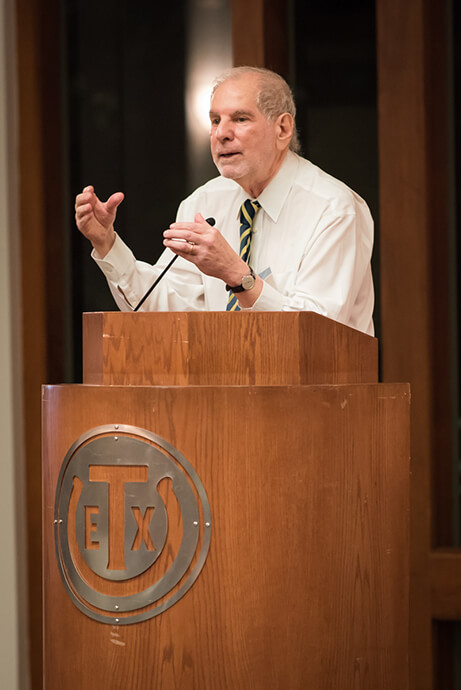The 2018 IMPACT: Improving Mathematical Prowess And College Teaching provides recommendations and a framework for improving mathematics education in the first two years of college. The American Mathematical Association of Two–Year Colleges (AMATYC) presents guidance on enhancing the mathematical prowess of students and how to continuously improve teaching.
Key themes include four pillars enabling student–centered change:
- Proficiency: Developing students’ mathematical knowledge
- Ownership: Taking responsibility and showing initiative
- Engagement: Developing intellectual curiosity and motivation in learning mathematics
- Student Success: Stimulating student achievement in mathematics
Additionally, the publication shares examples of collaborative innovation. The Dana Center’s role in the innovation of mathematics education, explored in chapter seven, covers a model for accomplishing effective change. This model focuses on five key elements of change: The work must be (1) student–centered, (2) policy–enabled, (3) administratively–supported, (4) culturally–reinforced, and (5) educator–driven.
Support for math pathways
The IMPACT publication draws on takeaways from the Dana Center’s Mathematics Pathways work, which leverages effective strategies for change. Dana Center Manager Amy Getz recognizes that mathematics pathways work at the local, cross–institutional, and state–wide levels “takes time and commitment and needs someone to manage the process to make sure that important details that might negatively impact students are anticipated and avoided” (p. 66).
For more information on companion resources, please visit the AMATYC website: https://amatyc.site-ym.com/.
The Common Vision project brought together leaders from the five largest professional associations of mathematical sciences to identify the areas of consensus in their instructional policy documents and to develop common action agendas for implementation. Dana Center Executive Director Uri Treisman is a member of the project’s leadership team. Common Vision culminated in a two-and-a-half-day workshop in May 2015 at the ASA headquarters in the Washington, DC, area. Over 50 participants represented the five aforementioned mathematical sciences associations, partner STEM disciplines, and industry. Seventy-five department chairs and professional society leaders developed policy recommendations that were submitted to the White House Office of Science and Technology Policy in Summer 2015.
Support for math pathways
The coalition published a report, A Common Vision for Undergraduate Mathematical Science Programs in 2025, calling for “multiple pathways into and through mathematical sciences curricula, some of which should include early exposure to statistics, modeling, and computation” (p. 13).
Further work, drawing upon thought leaders AMATYC, is the Winter 2018 IMPACT: Improving Mathematical Prowess And College Teaching. This report presents clear guidance on enhancing the mathematical prowess of students and how to continuously improve teaching in the first two years of college.
For more information on companion resources, please visit the AMATYC website: https://amatyc.site-ym.com/.
The Dana Center works closely with TPSE Math, which is an informal group of mathematicians interested in making constructive changes in mathematics education. Members include Phillip A. Griffiths, Institute for Advanced Study, convener; Eric Friedlander, University of Southern California; S. James Gates, Jr., University of Maryland at College Park and PCAST; Mark Green, UCLA; Tara Holm, Cornell University; Karen Saxe, Macalester College; and Uri Treisman, The University of Texas at Austin.
The symbolic power of this group of six renowned mathematicians, scientists, and educators coming together to focus on improving undergraduate math education has garnered attention from the mathematics field. TPSE Math’s vision for the collective efforts of the broader math community is for postsecondary mathematics education to enable any student, regardless of his or her chosen program of study, to develop the mathematical knowledge and skills necessary for productive engagement in society and in the workplace. Since its inaugural meeting in June 2014, TPSE Math has demonstrated convening authority and is a magnet for rising leaders in the math community.
The establishment of a Mathematics Advisory Group (MAG) marks the evolution of TPSE Math from information-gathering activities toward a more action-oriented role. The MAG will spearhead an effort to carry out, scale up, and evaluate the effectiveness of major reforms.
Support for math pathways
TPSE Math has identified mathematics pathways as one area of focus. At the initial meeting of TPSE MAG, participants discussed pathways as one of the primary reforms for future action.
The CBMS represents 17 professional societies, all of which promote efforts related to mathematics. Its purpose is to promote understanding and cooperation among these national organizations in their efforts to promote research, improve education, and expand the uses of mathematics. The CBMS seeks to provide a forum for the discussion of issues of broad concern to the mathematical sciences community and has embraced the multiple mathematics pathways approach as one to bring to the forefront of their memberships.
Support for math pathways
The CBMS member society presidents expressed support for the collective efforts of several initiatives including TPSE Math and Common Vision 2025 in a statement. The CBMS is also a partner in the Advancing Mathematics Pathways for Student Success initiative (see below for more information).



